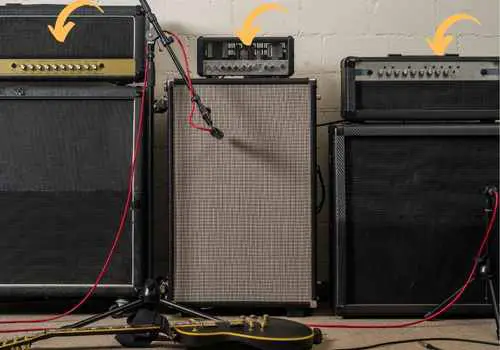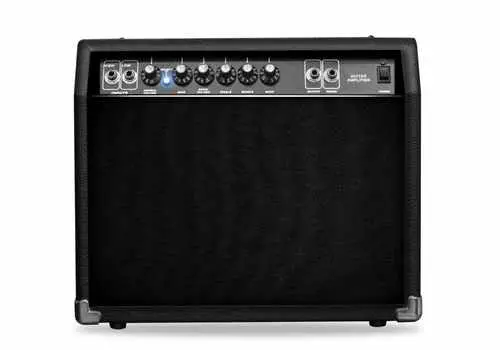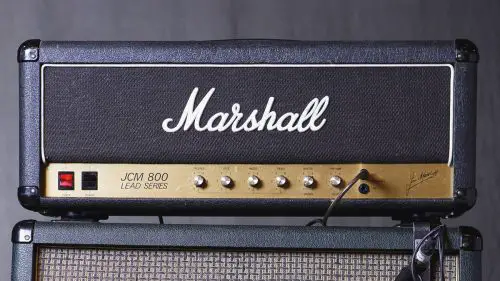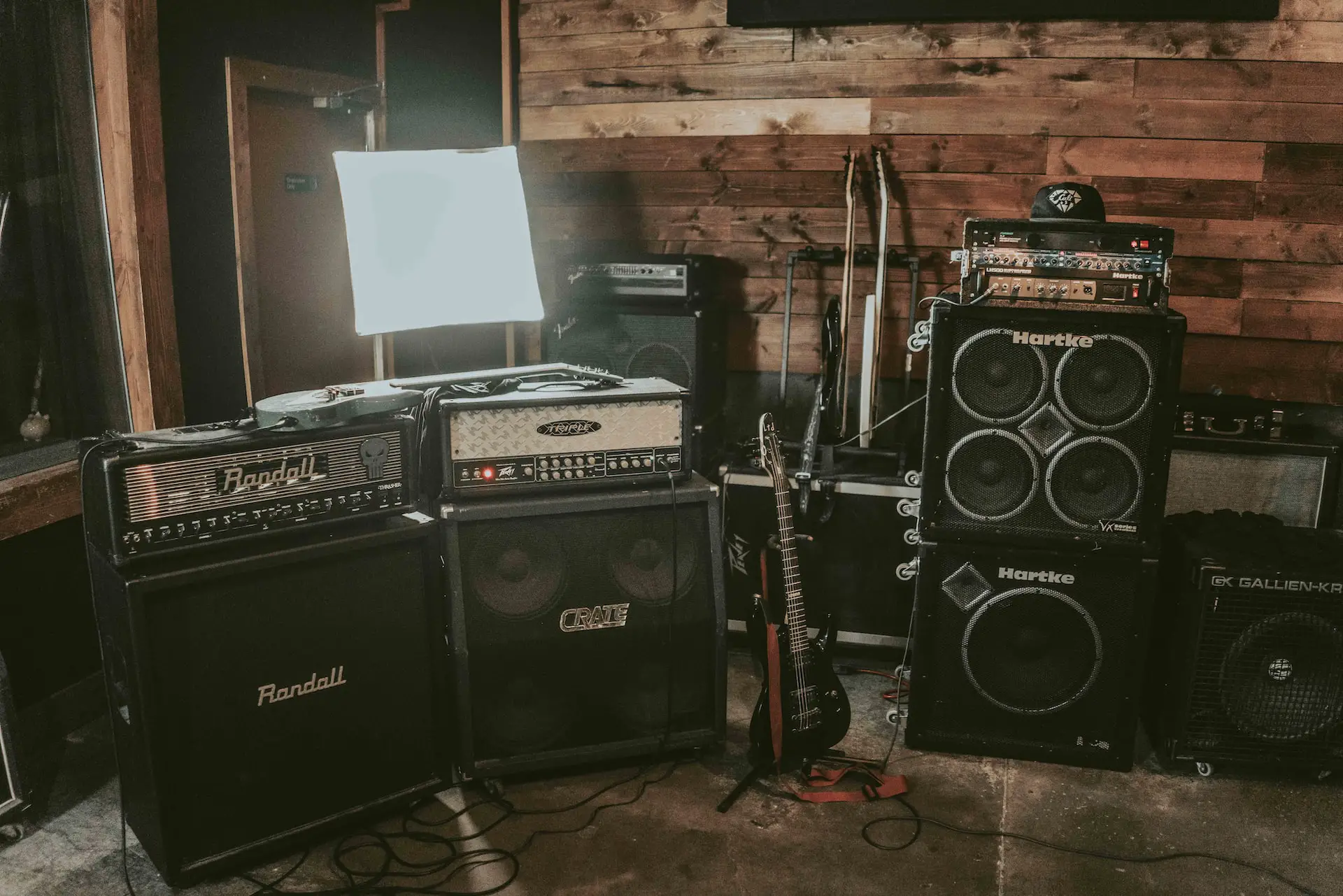You want to be able to create a variety of sounds, but you’re not sure if you should continue with a standard guitar amplifier or, for greater results, invest in an amp head and cabinet combo. You are unsure of the distinctions and whether you can perform using only amp heads. Well, …
As per the difference between an amp and an amp head, an amp is an all-in-one unit that may refer to a ‘combo amp’ or an amp head and a speaker working as one unit.
Whereas a head is used only to amplify the electrical signal but cannot produce sound because it doesn’t include a speaker. Amp heads must be paired with a speaker or cabinet.
So you can say the main difference between an amp and an amp head is that one comes with a built-in speaker while the other does not.
After reading this article, you will gain a better understanding of the distinction between an amp head and an amp, whether they can function independently, how to match an amp head to speakers or a cabinet, and the benefits and drawbacks of purchasing both an amp and an amp head.
Amp Head Vs Amp: The Difference
| Amp Head | Amp / Amp Combo | |
| What is it | Only amplification. | Includes amplification and speaker. |
| Comes with speaker | No | Yes |
| Can work by itself | No | Yes |
| Cost | More expensive (combined with amp cabinet) | Cheaper |
| Customization | Yes | No |
| Weight | Lighter | Heavier |
| Volume | Louder | Softer |
| Suitable for | Large venues | Small to medium venues |
What Is It: Amp Head Vs Amp

Amp head (doesn’t come with speaker out of the box)
An amplifier without a speaker is simply referred to as a “head.” It is an amplifier for guitars without an internal speaker. To hear the sound, you must connect to a different speaker cabinet or “cab”. Whereas an amp is most likely a speaker and amplifier housed in the same cabinet.
An amp head is a term used to describe an amplifier without speakers. On the other hand, a guitar amplifier is a combination of an amplifier and speaker in one cabinet.
Coupled with a good cabinet, your amp head cab create a powerful, audible sound. It’s better to use a head and cab setup if you want a more customized sound. You can produce a sound that is louder and more powerful because you have more control over the sound.
Now, because amp heads can produce more volume by connecting additional speakers, using large cabinets, or both, they have better power capacities and are suitable for Large venues like amphitheaters, arenas, and large clubs.

Regular Amplifier (comes with speaker)
Your existing guitar amplifier is most likely a speaker and amplifier housed in the same cabinet – also known as ‘amp’. Comparable arrangements are heavy and difficult to lug about. Most people build speakers instead of mounting heads on top of their amplifiers.
Additionally, when linked to speaker cabinets, guitar amps, unlike amp heads, have a very narrow frequency range. This means that, in comparison to a speaker system (or headphones) with a wide frequency range, music played through a guitar amp will probably sound muddy and low-quality.
Again, combo amps or amps frequently have a more classic amplifier appearance while amp heads or head and cabs can be sleeker and more modern, which is what most players desire.
Can Work By Itself: Amp Head Vs Amp
An amp head cannot possibly be used by itself. It cannot produce sound on its own, so it must be connected to a speaker cabinet. However, you can use amplifiers that way. They can function independently, but their output would not be as clear or loud as an amp head setup (head and cabinet).
Cost: Amp Head Vs Amp
The cost of amplifiers is typically lower than that of head and cab (amp head) arrangements. Even though there is a wide range of amp sizes and price points, amp heads with cabinets still often cost more.
This is because, if you don’t change the speakers, the sound you get from a complete amplifier is typically fixed. However, if you have a head, you can purchase whatever cabinet you like, which may significantly alter the sound. Thus, you will have the opportunity to become more versatile with a head. So, it’s natural for it to cost more.
Pros & Cons: Amp Head Vs Amp
AMP HEAD: Pros
- More customization. There are several options available when purchasing an amp head (heads and cabinets). You can mix and match various heads with various cabinets because they are not in the same piece of equipment. This enables you to play around with your sound and aids in finding the ideal harmony.
- Less Weight. Each piece of the head and cabinet may be lighter than a combo amplifier because they are two separate pieces of equipment. You won’t have as much trouble carrying something extremely heavy, even though you will need to make two trips to get the head and cab where you need them.
- Larger venue size. The head and cab may provide you with better projection if you’re playing larger venues, especially outdoor ones. With this amp setup, you might get more power, which translates to more volume.
AMP HEAD: Cons
- Less portable. Because it is not a single physical unit like a complete amp, the amp head setup can become heavy and less portable to carry.
- More costly. Another drawback of the amp head configuration is this. Given that you would have to purchase them separately, they are typically more expensive.
- More effort. An amp head requires more setup than a complete amp does.
AMP/ COMBO AMP: Pros
- More compact. Although it may be easier to transport the head and cabinet, it is less convenient. With a combination amp, everything is contained in a small unit that only needs to be transported once. They’re excellent for athletes that travel frequently or need to swiftly pack up their gear.
- Less costly. Combo amplifiers are frequently less expensive than an amp head and cab configuration because you are only purchasing one piece of equipment as opposed to two.
- More back options: open versus closed. You can choose between an open or closed back on a combo amp as well. Closed-back speakers only produce sound from the front. Whereas, an open-back speaker produces sound from both sides. The majority of combo amplifiers have an open back.
- Small to medium venue size. A combination amp can be adequate if your gigs are largely local, intimate events. This kind of amp is far more versatile than you may imagine.
- Less effort. Setup time is shorter than with an amp head and cab. One doesn’t need to remember the lead that connects the amp to speakers since it’s built in.
AMP/ COMBO AMP: Cons
- No customization. With amps, you are stuck with one particular kind of sound that these combos give. Unlike the head and can be set up where you are flexible to choose sounds by mixing models of your choice.
- Weaker output. Concerning sound or volume, it is not as powerful as a head and cab configuration which makes it not suitable for larger venues or gatherings.
- Less portable. Some combo amplifiers can be heavy.
- More costly. Some combo amplifiers can be very expensive.
Conclusively, you are better prepared to pick the right one for your own needs. If you can, test out both setups. See which one gives you the sound you like the most and enjoy it!
Which Is Better: Amp Head Vs Amp

Choosing between amp head an amp depends on your priorities
Amp heads is better if you are playing in larger venues or if you aspire to be a pro. Amp heads have more power and versatility than amps. This is because you can combine and contrast various heads and cabs to obtain the ideal sound for your purposes.
If you want a lot of power, for instance, you might couple a high-wattage head with a 4×12 cabinet. A full stack is what is meant by this. You could also combine a lower-wattage head with a 1×12 or 2×12 cabinet if you want something smaller.
But a regular amp might be your best option if you’re searching for something lighter, more portable, and needs less setup. Even if the speaker might not always be the greatest for your sound, it can always be changed.
A head and cab combination would, in my opinion, be preferable if you like to use more speakers with your head or prefer different tones.
How Do You Match Amp Head and Cabinet?
To match amp heads and cabinets, you need to be aware of the amp heads’ impedance. Then, check the power output of your amp in each impedance mode and make sure it can operate at the impedance the speaker cabinet is wired for.
Impedance can be written as (ohms). Most cabinets are either 4 or 8 feet long (ohms). Although the majority of contemporary amps have features built into them that let them choose what impedance to operate at when you connect them to the speaker cab.
Finding the ideal speaker cabinet for an amp head can be challenging. However, choosing an amp and speaker set that will produce the required results can be made simpler if you have a basic understanding of amp head impedance, power, cabinets, and what to look for. In this manner, your amp heads will function at their peak efficiency, deliver the output and sound you desire, and guard against damage so they can last for many years.
In actuality, you don’t require a particular amp head with a particular cabinet. To achieve the ideal sound, you can mix and match different amp heads and speaker cab models. As long as you pair them correctly and take into account their impedance, they are guaranteed to function.
Be aware that your speakers may sustain significant damage if the amp and speaker cabinets have different impedances.
FAQs
Does an Amp Head Need a Speaker?
Amp head needs an additional speaker. A guitar cannot be played through an amp head alone. The head doesn’t utter a sound by itself. A speaker cabinet must be attached to them. Therefore, an amp head is silent without a speaker.
A guitar amplifier without a built-in speaker is called a “head.” To hear the sound, you must connect to a different speaker cabinet or “cab”. This contrasts with combo amps or “combos”, where the amplifier and speaker are enclosed together in one physical unit.
Does an Amp Head Need a Cabinet?
Amp head needs a cabinet. Without a cabinet, an amp head is useless. You require both elements. Any tube amplifier must be connected to a speaker or cabinet to be used safely.
The speaker is the most popular technique to provide a load for an amplifier, but you may also use a “dummy load” in place of a cabinet.
The speaker or cabinet serves as a “load” that directs the amp’s output, which must go somewhere. Your amplifier is prone to harm without this load. Your transformer could end up blowing up, or you could even start a fire!
Can You Use an Amp Head With Any Cabinet?
You can use an amp head with any cabinet as long as the impedance matches (Vice versa). If you match the amp with the right speaker impedance, you can mix different models and brands to get what you want.
This makes performing live, recording, practising with a band, and even updating your equipment, really simple. Additionally, since you will be carrying both parts separately, sound-checking should be much simpler.
The point is that every amp head must be linked to a load of some description. A certain resistance is present in speaker cabinets and amplifier heads. This is why any amp head and cabinet have ohmage specifications (labeled as “Ω”). It’s important to take care of impedance and to have cabinets and amp heads with matching ohmage and sure, you are good to go!
Can You Use an Amp as a Head?
It is possible to use an amp only as a head. However, you might not get the most from your sound.
So, I recommend that you get an amplifier that can handle the speakers’ wattage. A head unit will not be as effective at powering speakers as an amplifier, which is designed to do so. Decide on a head unit that has the characteristics you want.





